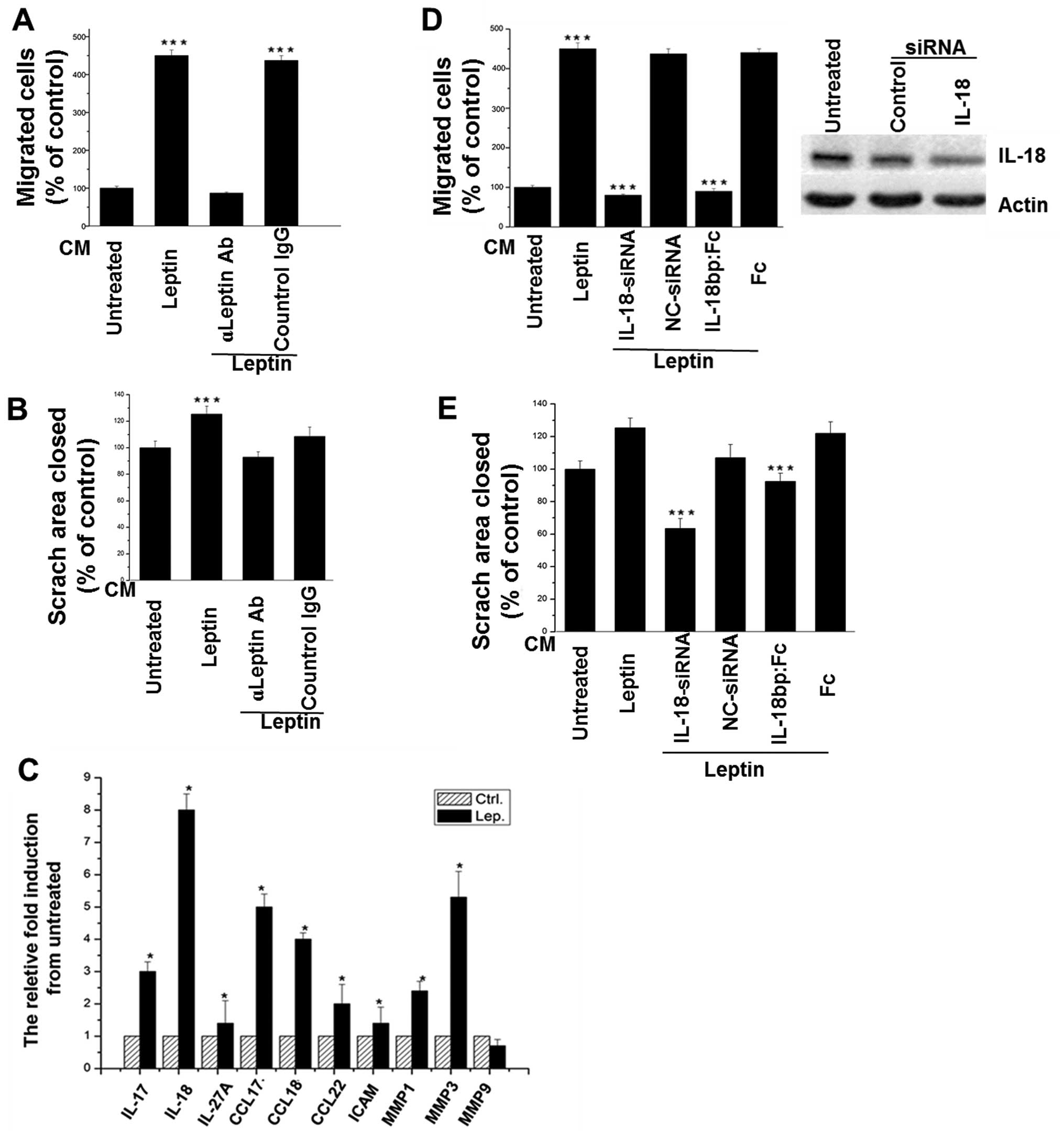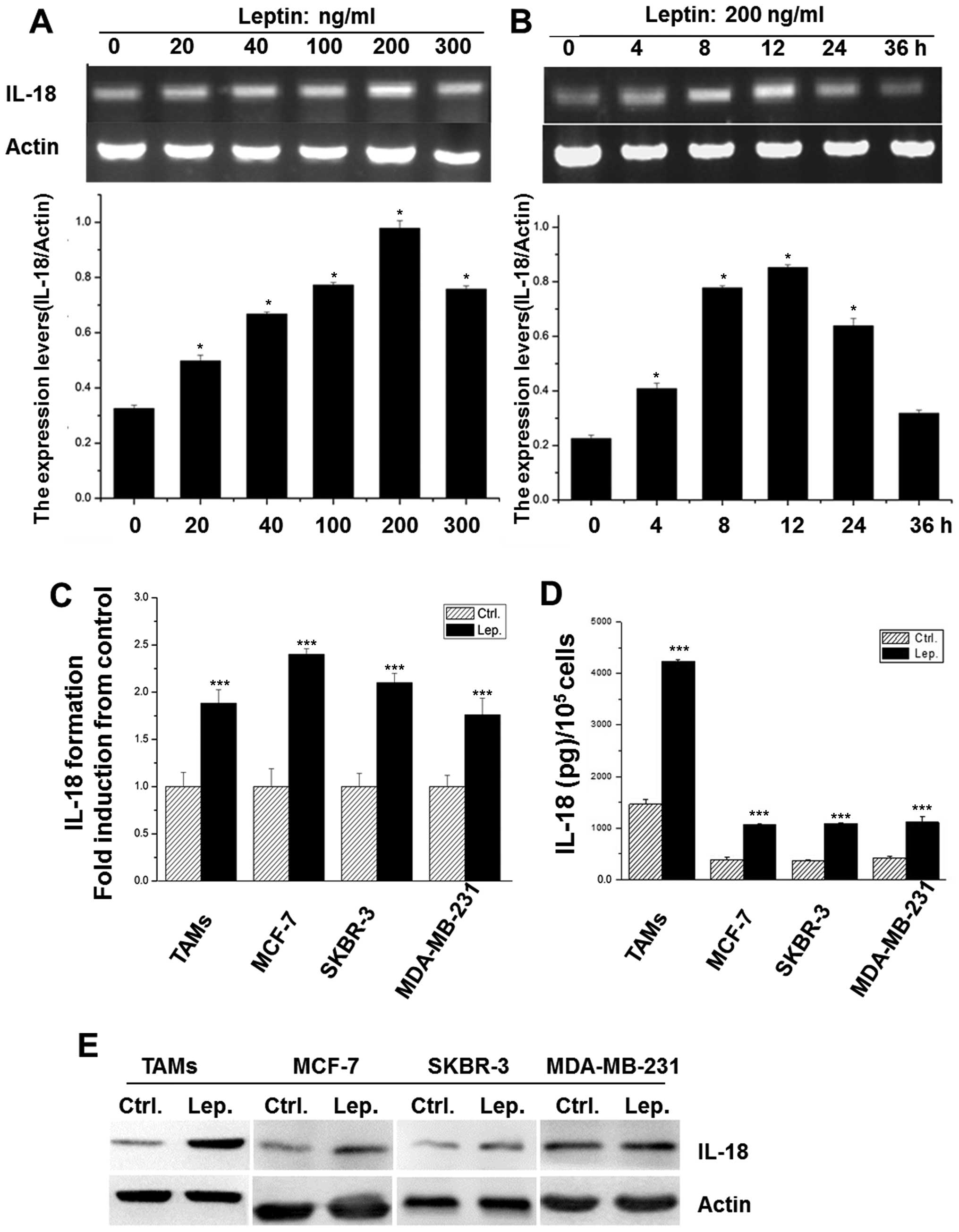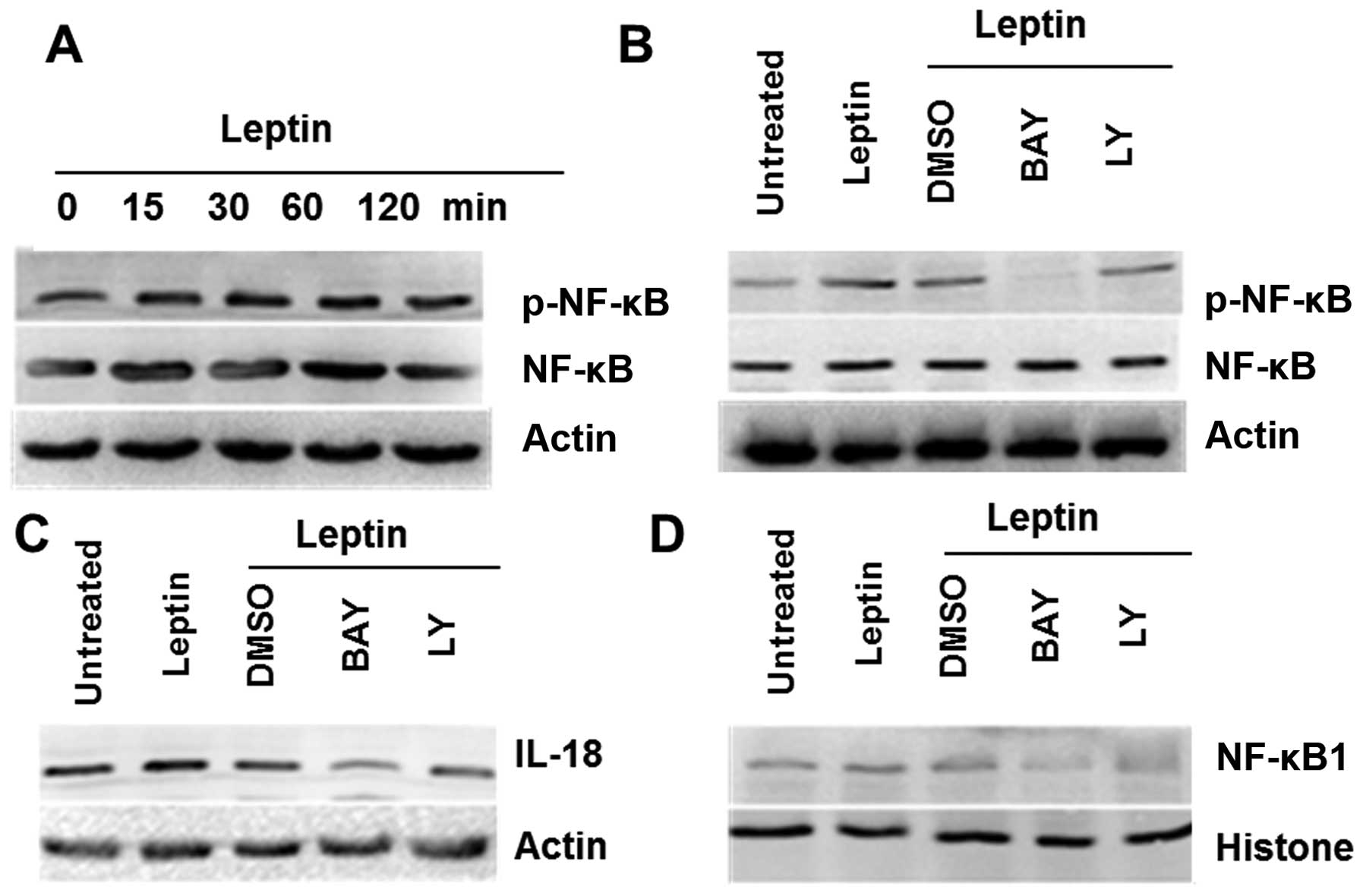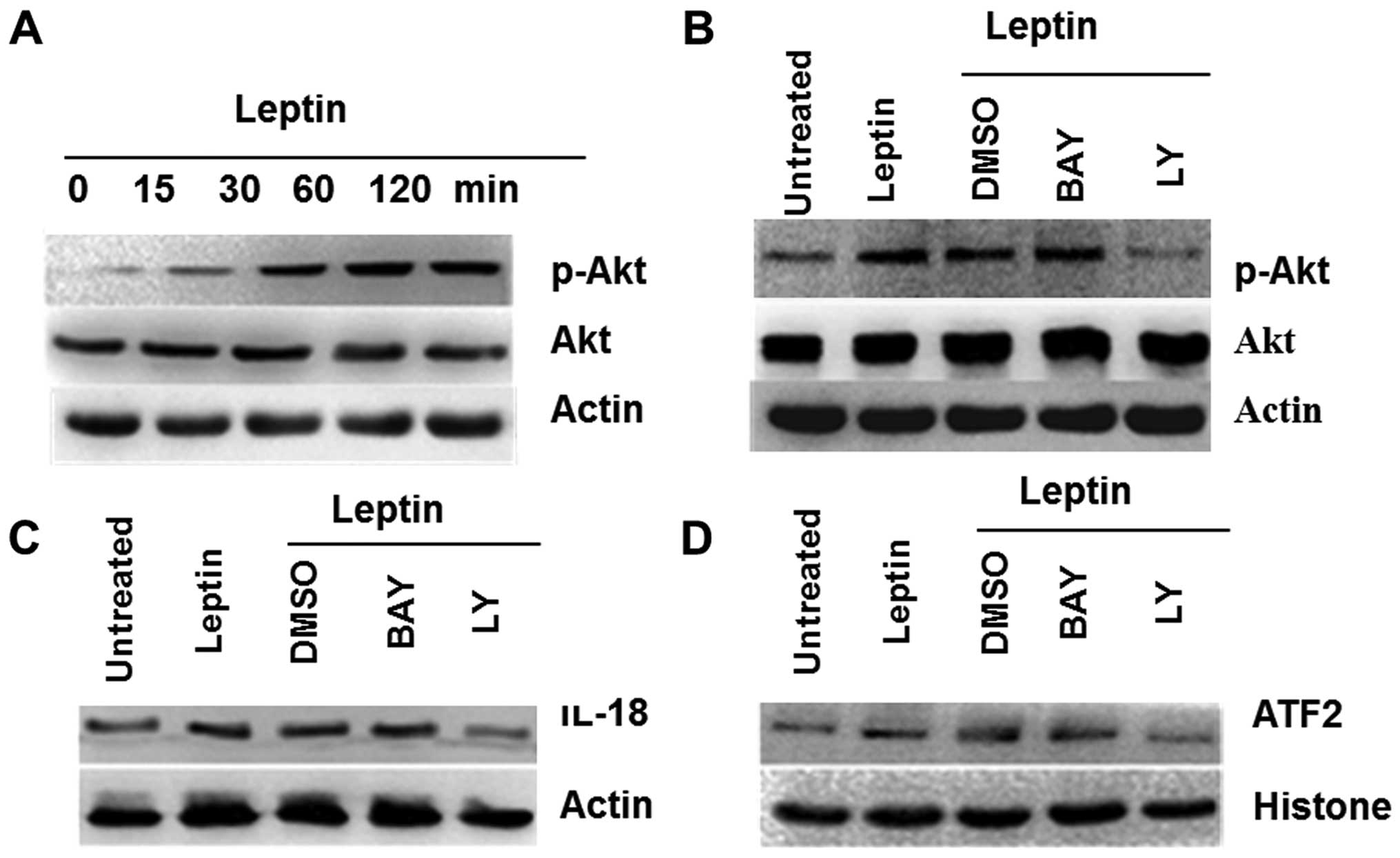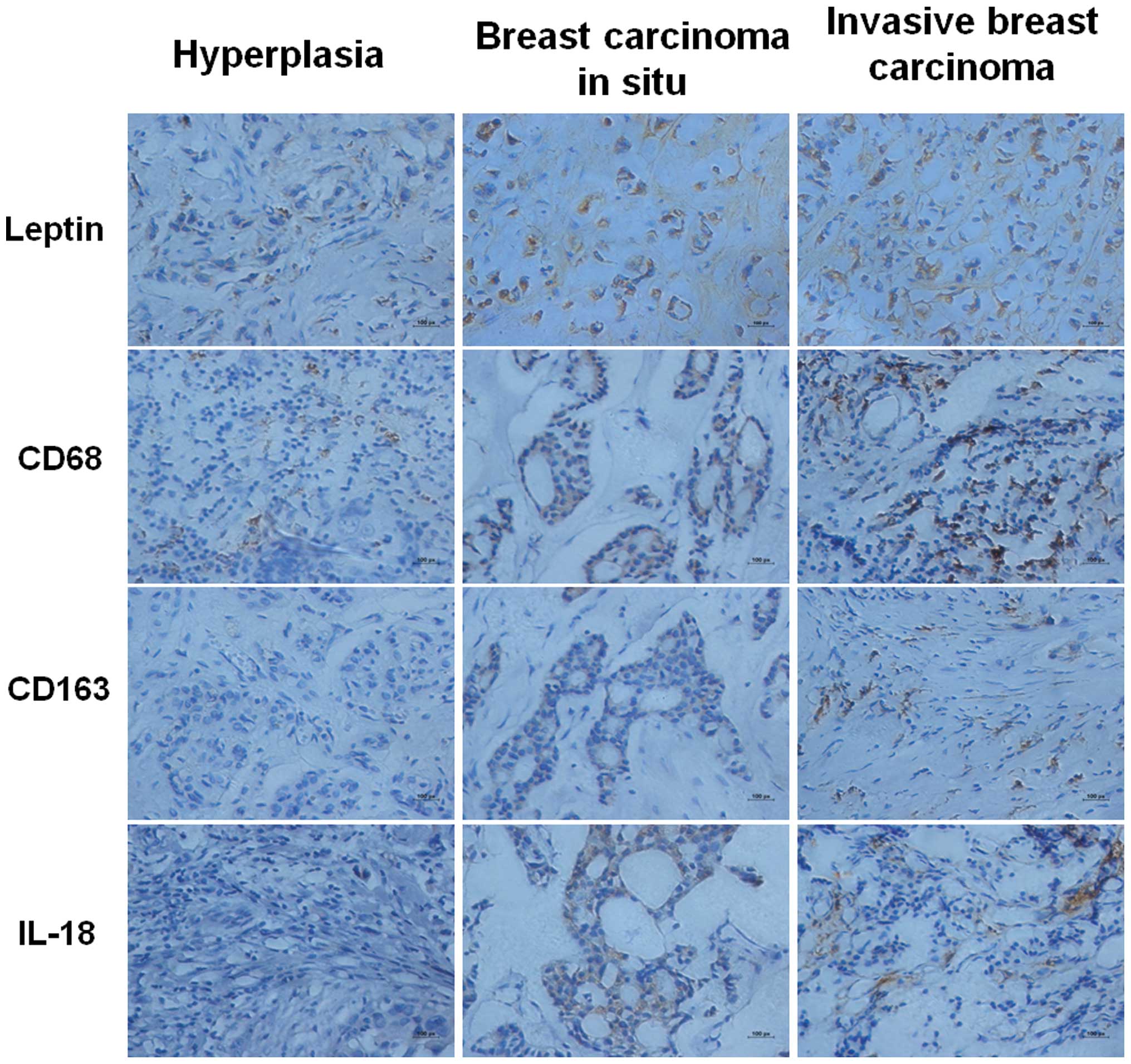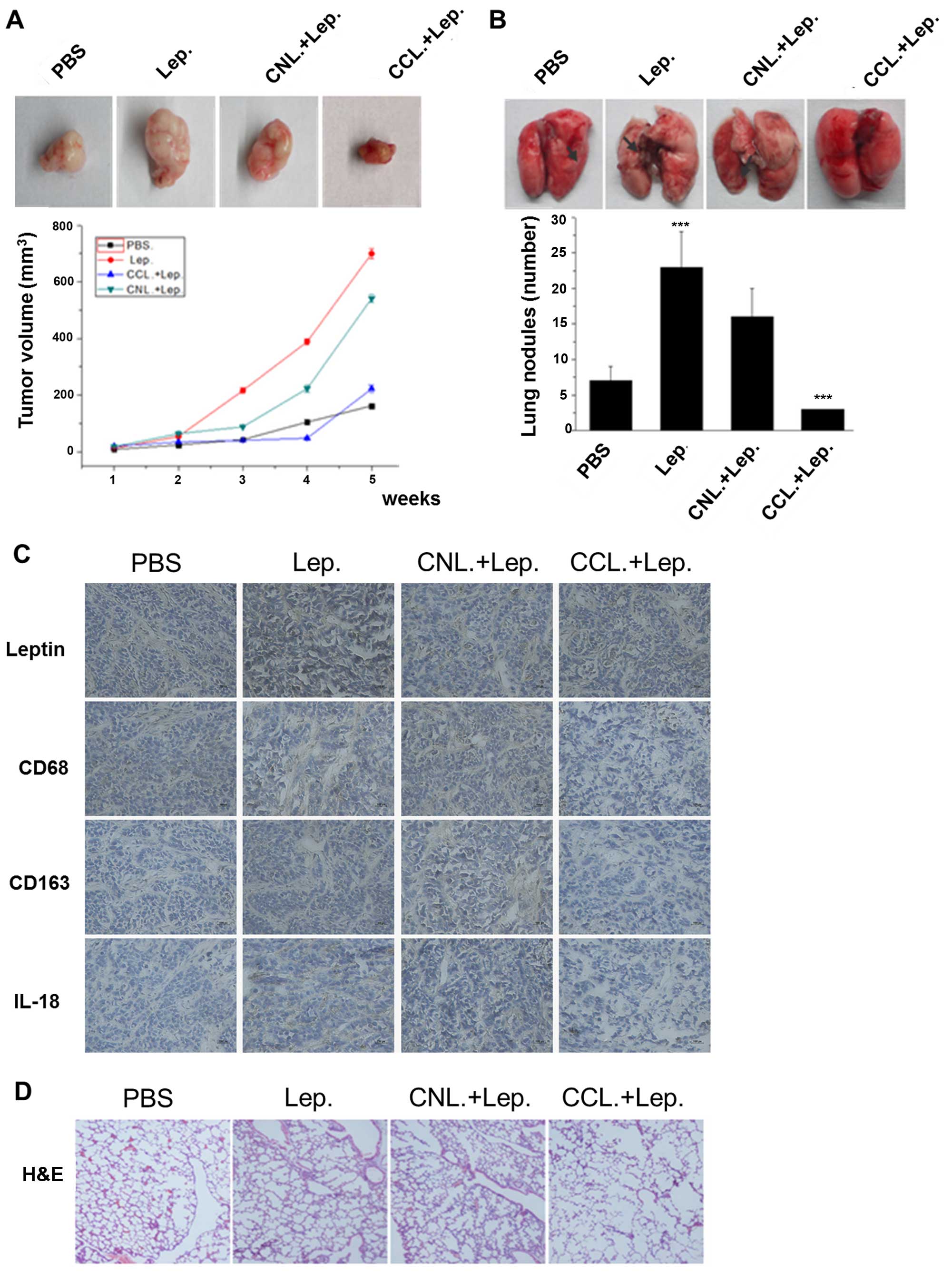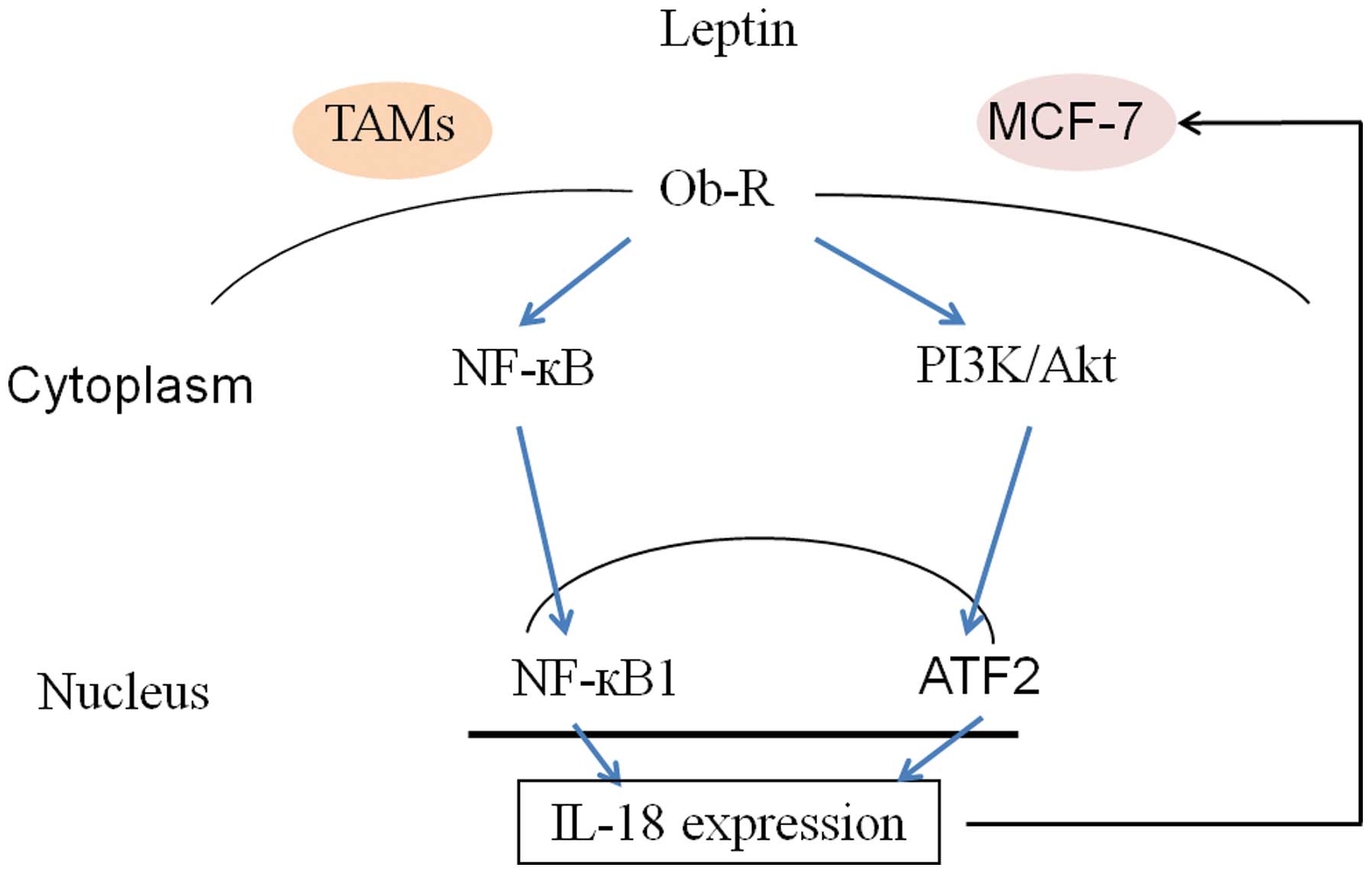Leptin promotes breast cancer cell migration and invasion via IL-18 expression and secretion
- Authors:
- Published online on: April 12, 2016 https://doi.org/10.3892/ijo.2016.3483
- Pages: 2479-2487
Abstract
Introduction
In the last three decades, cancer research focused predominantly on breast cancer cell characteristics. Recently, compelling evidence has emerged that metastatic breast cancer development depends upon essential contributions from the tumor microenvironment, which is composed of a wide range of hematopoietic cells, adipocytes, fibroblasts, as well as the important immune effector cells, and soluble signal factors secreted by these cells (1–4). Adipocyte, initially considered only to be a fat-storing cell, is now recognized as a key components in tumor microenvironment. It plays complex functions mainly mediated by a variety of adipocyte-derived molecules, named adipokines. The adipokines are deemed to be key mediators linking obesity with breast cancer, and among which, leptin, whose synthesis and plasma levels increase in parallel to total adipose tissue mass, has been extensively examined in this regard.
Leptin is a 16 kDa protein encoded by the ob gene. It is a pleiotropic molecule that is related to food intake, inflammation, cell differentiation, and proliferation of different cell types including breast cancer cells (5). The activities of leptin are mediated through the transmembrane leptin receptor (ObR). Leptin and leptin receptor are overexpressed in breast tumors, but not in the normal cases. Its binding to ObR induces activation of canonical (JAK2/STATs; MAPK/ERK 1/2, PI3K/AKT) and non-canonical (PKC, JNK, p38 MAPK and AMPK) signaling pathways that increase breast cancer cell proliferation and transformation, exert anti-apoptotic effects, induce the expression of cell cycle modulators, reduce efficacy of breast cancer treatment, and influence cancer initiation processes (6,7).
As is well known, inflammation is involved in almost all tumor pathological processes. Notably, leptin, through induction of pro-inflammatory cytokines and stimulation of macrophage function, has pro-inflammatory effects (8). Leptin receptor is widely expressed in immune system and activates a number of independently regulated intra-cellular signalling pathways which are important in cytokine gene regulation, including JAK2/STAT, PI3K and MAPK (9). Thus, in vitro, leptin influences cytokine secretion in a variety of cells including the monocytes/macrophage lineage (10–12). For example, treatment with leptin enhances the production of proinflammatory cytokines such as tumor necrosis factor-α (TNF-α) and IL-6 by macrophages (13–15). Here, macrophages, also known as tumor-associated macrophages (TAMs), exhibit marked phenotypic heterogeneity and functional diversity results from a differentiation program that is subject to environmental imprinting (16–18). It comprises of classically activated macrophages (M1 macrophages) and alternatively activated macrophages (M2 macrophages). Clinical evidence has revealed a strong correlation between a high density of TAMs and poor prognosis in breast cancer. Analysis of the transcriptome of TAMs in mouse models of breast cancer has also provided evidence that an enrichment in macrophage transcripts is predictive of poor prognosis and reduced survival (19). However, the molecular mechanisms underlying these observations remain unclear.
IL-18, a member of the IL-1 family, is a pro-inflammatory cytokine that initially was thought to be produced by activated macrophages. Now it has been confirmed being expressed by both immune and non-immune cells (20,21). IL-18 was originally described as an interferon-γ-inducing factor with an anti-tumor activity through the activation of NK and/or T cell responses (22,23). However, some studies demonstrated that IL-18 has a pro-tumor effect in different cancers. Increased IL-18 levels in the serum of cancer patients correlated with malignancy, and IL-18 acts as a crucial factor for cell migration in gastric cancer and melanoma (24,25).
In the present study, we examined the effect of leptin on breast cancer progression. We showed that leptin promotes the migration and invasion of breast cancer cells via activation of IL-18 signalling, which is TAM-dependent or -independent. Overall, our findings suggest that leptin and TAMs, acting together or independently, were involved in the mammary tumor cell migration and invasion.
Materials and methods
Cell lines
THP1 human monocytes, and MCF-7, SK-BR-3 and MDA-MB-231 human breast tumor cell lines were obtained from American Type Culture Collection (ATCC). THP1 cells, and MDA-MB-231 cells were cultured in RPMI-1640, and MCF-7 and SK-BR-3 cells were kept in Dulbecco's modified Eagle's medium supplemented with 10% fetal bovine serum, penicillin (100 U/ml) and streptomycin (100 μg/ml).
THP1-derived macrophages
To generate THP-1 macrophages, 5×105 THP-1 cells were seeded into a six-well plate and treated with Phorbol-12-myristate-13-acetate (PMA) 100 nM for 6 h and then cultured with PMA plus 20 ng/ml IL-4 for further 66 h (26,27). PMA treatment, which activates protein kinase C (PKC), also induces a greater degree of differentiation in THP-1 cells as reflected by increased adherence and expression of surface markers associated with macrophage differentiation. Furthermore, cells were stimulated by IL-4 to differentiate to M2 macrophages, which are in general more prone to protumoral activities.
Specimens
The 48 surgical specimens were obtained from women undergoing surgery for breast carcinoma or reduction mammoplasty after informed consent was given by the Department of Pathology of the First Affiliated Hospital of Chongqing Medical University (Chongqing, China). None of the patients had received pre-operative chemotherapy. The experiments were approved by the Ethics Committee of the First Affiliated Hospital of Chongqing Medical University and were conducted in accordance with the Helsinki Declaration.
Materials
Cytokine leptin (300-27) was obtained from Peprotech, Inc. (Rocky Hill, NJ, USA), antibody leptin (ab3583) and IL18 (ab117342) were purchased from Abcam (Cambridge, UK), IL-18 bp (10357-H08H) was purchased from BioVision, Inc. (Milpitas, CA, USA), antibody for pAKTSer473, AKT, pNF-κB, NF-κB and NF-κB1 were obtained from Cell Signaling Technology, Inc. (Danvers or Beverly, MA, USA), antibody for ATF-2 (AB55011) CD68 (ZM0060) and CD163 (AB60965a) were purchased from Sangon Biotech (Shanghai, China), β-actin (Santa Cruz Biotechnology, Inc., Santa Cruz, CA, USA), HRP anti-mouse or rabbit IgG (Beyotime, China) was used as secondary antibody, ELISA kit was purchased from USCN Life Science Inc. (Los Angeles, CA, USA). IL18 siRNA: (IL-18-459, sense, 5′-CCUAGAGGUAUGGCUGUAATT-3′; and antisense, 5′-UUACAGCCAUACCUCUAGGTT-3′) were purchased from GenePharma (Shanghai, China). PI3k inhibitor Ly294002 and the NF-κB inhibitor Bay11-7082 were obtained from Beyotime.
In vitro cell migration assay
The conditioned medium (CM) was collected. The monocyte THP1 differentiated to TAMs according to the projected protocol, and then the TAMs were treated with different factors for various time periods. The cells were washed with serum-free medium and then with fresh medium with 5% FBS, the supernatants were collected at 36 h after cell culture and then stored at −20°C for future use.
A 24-well plate of 8.0 μm pore-size diameter polycarbonate (PC) membrane Transwell inserts (Corning Inc.; Corning, NY, USA) were coated with Matrigel (Sigma; St. Louis, MO, USA). Breast cancer cells (50,000) suspended in 100 μl of DMEM medium (supplemented with 1% FBS) was added to the upper compartment of the Transwell and placed into the lower chamber containing the collected CM with 1% FBS. After 24 h, Transwells of each condition assessed in triplicate were removed, the upper side of the compartment of the PC membrane was wiped clean using a cotton swab and the lower compartment was fixed with 1% paraformaldehyde and stained with 0.1% crystal violet for 10 min. The number of cells passing through the Matrigel was counted in five random fields under a microscope and the average number of cells per experimental condition is reported.
Scratch assay
The breast cancer cells were counted and plated at 4–6×105 cells/ml in 12-well dishes. Cells were incubated in the collected CM with 1% FBS overnight yielding confluent monolayers for wounding. Wounds were made using a pipette tip and photographs were taken immediately (time zero) and 24 or 36 h after wounding, respectively. The distance migrated by the cell monolayer to close the wounded area during this period was measured. Results were expressed as a migration index. Experiments were carried out in triplicate and repeated at least five times.
Real-time PCR
The expression of IL-18 mRNA was analyzed over a 12-h period for all four cell lines to determine if leptin regulates IL-18 gene expression. Total RNA was isolated using the TRIzol reagent (Invitrogen) and was reversely transcribed into first-strand complementary DNA (Takara) according to the manufacturer's instructions. Quantitative real-time reverse transcription PCR (qRT-PCR) was performed using SYBR Green Premix Ex Taq™ (Takara). The following primers: IL-18 forward: 5′-CCAGCCTGACCAACA-3′ and IL-18 reverse: 5′-CCACAACCTCTACCTCC-3′ were designed using Primer primer 5.0 and synthesized by Invitrogen. Data were analyzed according to the comparative threshold method and normalized against the actin internal control transcript.
ELISA
Supernatants obtained from breast cancer cells cultured alone or treated with leptin were subjected to ELISA, according to the manufacturer's instructions.
In vivo orthotopic animal study
Female nude BALB/c mice, aged 6–8 weeks, were purchased from Center of Laboratory Animals, Chongqing Medical University. Selective macrophage depletion, by means of the macrophage suicide technique utilizing liposome-mediated intracellular delivery of dichloromethylene-biphosphonate [Cl2MBP (clodronate)] is a well-established experimental protocol (28,29). MCF-7 cells (1×106) were inoculated into the mammary fat pads of nude mice, and cancer evolution and metastasis to the lungs were evaluated. From the 15 days after tumor cells inoculation, mice were injected with PBS or leptin at 0.1 μg/g biweekly, leptin with clophosome-clodronate liposomes (CCL) or control neutral liposome (CNL), as initial dose of 0.2 ml per mouse, followed by 0.1 ml per mouse once a week for 5 weeks, respectively.
Immunohistochemistry
Nude mouse tumor tissues were fixed in 10% neutral buffered formalin. Sections (5 μm) of formalin-fixed and paraffin-embedded tissue were placed on slides. The procedure operated as the basic protocol of immunohistochemistry, all the antibodies were diluted at 1:50. The tissue sections were scored quantitatively according to the percentage of positive cells and staining intensity in five random fields under a microscope.
Statistical analysis
All quantitative results are displayed as the average value ± the standard deviation. To determine statistical significance, SPSS for Windows version 17.0 software was employed. Using a 95% confidence interval, ANOVA was conducted for each variable independently and as interacting factors, p-values <0.05 resulted in a null-hypothesis rejection.
Results
Leptin stimulates breast cancer MCF-7 cell invision and migration via IL-18 secreted in TAMs
As shown in Fig. 1, after treated by leptin, the conditioned medium (CM) of TAMs significantly enhanced the migration and invasion of breast cancer cells. However, the effect was abolished by the leptin-neutralizing antibody (Fig. 1A and B). In addition, it was found that an array of cytokines was increased in the CM of TAMs, such as IL-17, IL-18, IL-27A, as well as CCL-17, CCL-18, and CCL-22 (Fig. 1C). IL-18 was the most elevated, and involved in promoting migration (Fig. 1D) and invasion (Fig. 1E) of breast cancer cells, confirmed by the addition of IL-18 siRNA or IL-18BP-Fc chimeras.
Leptin induces IL-18 expression in TAMs and breast cancer cells
Treatment with leptin visibly increased IL-18 expression of TAMs in a dose- and time-dependent manner (Fig. 2A and B), and 200 ng/ml leptin at 12 h exerted the maximum effect and was chosen for further experiments. Additionally, the direct effect of leptin on IL-18 expression was also investigated in different breast cancer cell lines, including MCF-7, MDA-MB-231, and SK-BR-3. As shown in Fig. 2C and E, after treated with leptin, the mRNA and protein levels of IL-18 were significantly increased in these cells, which was strengthened by the detection of IL-18 in all the supernatants by ELISA assay (Fig. 2D).
Leptin-induced IL-18 expression varies in TAMs and MCF-7 breast cancer cells
On the basis of leptin-induced IL-18 overexpression both in TAMs and breast cancer cells, some of inhibitors, Bay11-7082 (inhibitor of NF-κB) and Ly294002 (inhibitor of PI3K), were used to elucidate further molecular mechanisms. The results showed that NF-κB in TAMs and PI3K in MCF-7 cells were activated by leptin, respectively (Figs. 3A and 4A). Furthermore, the effects of leptin on induction of NF-κB phosphorylation in TAMs were also significantly attenuated by a pharmacological NF-κB inhibitor (Fig. 3B), and for breast cancer cells MCF-7, PI3K inhibitor affected the decrease of Akt phosphorylation (Fig. 4B). Bay11-7082 decreased the overexpression of IL-18 in TAMs induced by leptin (Fig. 3C), and Ly294002 played a similar role in MCF-7 cells (Fig. 4C). These results indicated that leptin induced IL-18 expression in TAMs and in MCF-7 via NF-κB, the PI3K signaling, respectively.
Moreover, western blotting of nuclear protein extracts revealed a significant increase of NF-κB1 in TAMs and ATF-2 in MCF-7 (Figs. 3D and 4D) treated by leptin, and the effects were blocked by its pharmacologic inhibitors.
Leptin promotes metastasis of breast tumor cells in vivo by the secretion of IL-18 in TAMs
The expression of IL-18 in the leptin-induced TAMs were correlated closely with malignant breast cancer, suggesting that the CD163, a sensitive and accurate marker of TAMs (30), and IL-18 might be related to the evolvement of breast cancer directly. CD68 served as a marker of macrophages (30).
To test this notion, 48 human pathological specimens of breast cancer, previously scored for tumor grade, were tested to investigate the expression of leptin, IL-18, CD68 and CD163. Immunohistochemistry results revealed that the staining intensity of leptin in breast carcinoma without lymph node metastases (LNM) (17/20) was lower than in LNM (13/16), while stronger compared with that of benign breast tissue (8/12); CD163 and IL-18 were observed scattered in the tumor stroma cells of invasive breast carcinomas, few were identified in breast carcinomas in situ; the CD68 results were similar to CD163 (Fig. 5).
To determine the effect of IL-18 secreted in TAMs induced by leptin in vivo, intraperitoneal (i.p.) injection of CCL was used to deplete macrophages, and CNL as control. It was observed that the volume of tumor in leptin groups was significantly larger than that of PBS groups, and the tumor growth was reduced in CCL groups compared with that of CNL control group (p<0.05) (Fig. 6A). Pulmonary metastases were also observed in xenograft models. It was found that leptin greatly accelerated lung metastases, and macrophage depletion could suppress the metastasis (Fig. 6B). The expression of IL-18 was highly correlated with the expression of leptin, however, IL-18 was decreased under the macrophage depletion with CCL (Fig. 6C). We also investigated lung metastasis of breast cancer xenografts by H&E staining (Fig. 6D). Thus, these results in human breast cancer tissues and in animal models confirmed our observations in vitro, lending further support to our hypothesis that IL-18 of TAMs was required for cancer cell migration and invasion induced by leptin.
Together, our results indicated that the expression of IL-18 in TAMs induced by leptin may affect breast cancer cell migration and invasion.
Discussion
Leptin is a pleiotropic adipokine that regulates inflammatory cytokines, including IL-1 family, in different cell types and pathological conditions (31). However, published studies concerning the relationships between leptin and IL-1 family in breast cancer are scarce. In addition, leptin could probably regulate the function of TAMs, which is the main source of inflammatory cytokines in tumor microenvironment, nevertheless, the underlying mechnism is not fully understood. Here, we showed that leptin induced IL-18 expression both in TAMs and breast cancer cells. In our studies, leptin-induced IL-18 expression was regulated via NF-κB/NF-κB1 signaling in TAMs, while via PI3K-AKT/ATF-2 signaling in breast cancer cells, which, eventually lead to invasion and metastasis of breast cancer cells.
TAMs, derived from circulating peripheral blood monocytes, are a key component of the tumor microenvironment in aggressive tumors. Studies have demonstrated that increasing infiltration of TAMs is directly linked with advanced tumor prognosis and metastasis (13). These effects are regulated by multiple cues from tumor cells and the tumor microenvironment. Upon direct or indirect interaction with TAMs and tumor microenvironments, TAMs synthesized and released a vast diversity of growth factors, cytokines, chemokines, ECM components, and protease enzymes. These TAM-derived factors then promoted matrix remodeling, angiogenesis, anti-immune responses, and tumor progression (13). Data from the present investigation show for the first time that leptin upregulates the transcriptional expression of different cytokines of TAMs, including IL-18 as the most elevated. Additionally, after treated with leptin, TAMs significantly promoted the migration and invasion of breast cancer cells. Indeed, previously studies has demonstrated that IL-18 is a critical factor in the metastasis and pathogenesis of breast or other cancers, such as gastric cancer and melanoma (32). Consistently, in our study, co-incubation of IL-18 siRNA or IL-18BP-Fc chimeras abolished the effect of leptin-incubated TAMs in promoting the migration and invasion of breast cancer cells, indicating that IL-18 of TAMs was required for the cancer cell migration and invasion induced by leptin. To understand the mechanisms underlying the effect of leptin, we examined leptin-induced activation of NF-κB/NF-κB1 signaling pathway in TAMs. Our results showed that leptin stimulated the expression of NF-κB and its phosphorylation, with a significant increase of NF-κB1 induction, which, however, were inhibited by the addition of the pharmacological NF-κB inhibitor, Bay11-7082. Notably, leptin could also directly stimulate IL-18 expression in breast cancer cells, which, differently, was via the PI3K/AKT-ATF-2 signaling pathway. Herein, as shown in Fig. 7, our results suggest that interaction between TAMs and breast cancer cells, and as well as leptin- IL-18 crosstalk may promote cancer cells invasion and metastasis in autocrine and paracrine manner (Fig. 7).
Accumulating evidence suggests that the high level of TAMs infiltration in tumors, which correlates with poor prognosis, is advantageous to the spread of cancers via enhancement of tumor angiogenesis and tumor cell migration and invasion (33–35). To further verify our hypothesis that leptin-induced production of IL-18 from TAMs is responsible for the metastasis and pathogenesis of breast cancer cells, immunohistochemistry analysis of leptin, IL-18, CD68 and CD163 in human pathological specimens was carried out. The results showed that malignant breast carcinoma with lymph node metastases (LNM), which represents poor prognosis, exhibited stronger expression of leptin, IL-8, and TAM markers. Moreover, xenograft tumor-bearing mouse models showed that leptin significantly increased tumor volume, enhanced lung metastases, and increased expression of IL-8 and TAMs markers, which, nevertheless, were abolished by depletion of macrophages by clophosome-clodronate liposomes. Taken together, the assessment of the effect of TAMs on breast cancer suggests that the tumor microenvironment consisting of these TAMs could dictate the outcomes in breast cancer patients. Moreover, these findings suggest that leptin may be a novel therapeutic target for breast cancer treatment.
Our study showed that adipokine leptin triggered macrophage-related cytokine IL-18 production, possibly contributing to tumor progression. We anticipate the above results to have important implication in the development of treatment strategies for metastatic cancers, and their potential use in the identification and screening of novel therapeutic targets.
Acknowledgements
This study was supported by the National Natural Science Foundation of China (NSFC 81272544). The funding agencies had no role in study design, collection, analysis, or interpretation of data, writing of the manuscript, or the decision to submit the manuscript for publication.
Abbreviations:
|
ATF-2 |
activating transcription factor-2 |
|
CD163 |
cluster of differentiation 163 |
|
CM |
conditioned medium |
|
i.p. |
intraperitoneal |
|
NF-κB |
nuclear factor κB |
|
TAMs |
tumor associated macrophages |
|
TME |
tumor microenvrionment |
References
|
Coussens LM and Werb Z: Inflammation and cancer. Nature. 420:860–867. 2002. View Article : Google Scholar : PubMed/NCBI | |
|
Bhowmick NA, Neilson EG and Moses HL: Stromal fibroblasts in cancer initiation and progression. Nature. 432:332–337. 2004. View Article : Google Scholar : PubMed/NCBI | |
|
Robinson BD, Sica GL, Liu YF, Rohan TE, Gertler FB, Condeelis JS and Jones JG: Tumor microenvironment of metastasis in human breast carcinoma: A potential prognostic marker linked to hematogenous dissemination. Clin Cancer Res. 15:2433–2441. 2009. View Article : Google Scholar : PubMed/NCBI | |
|
Tlsty TD and Coussens LM: Tumor stroma and regulation of cancer development. Annu Rev Pathol. 1:119–150. 2006. View Article : Google Scholar | |
|
Andò S and Catalano S: The multifactorial role of leptin in driving the breast cancer microenvironment. Nat Rev Endocrinol. 8:263–275. 2011. View Article : Google Scholar : PubMed/NCBI | |
|
Guo S, Liu M, Wang G, Torroella-Kouri M and Gonzalez-Perez RR: Oncogenic role and therapeutic target of leptin signaling in breast cancer and cancer stem cells. Biochim Biophys Acta. 1825:207–222. 2012.PubMed/NCBI | |
|
Andò S, Barone I, Giordano C, Bonofiglio D and Catalano S: The multifaceted mechanism of Leptin signaling within tumor microenvironment in driving breast cancer growth and progression. Front Oncol. 4:3402014.PubMed/NCBI | |
|
Procaccini C, Jirillo E and Matarese G: Leptin as an immuno-modulator. Mol Aspects Med. 33:35–45. 2012. View Article : Google Scholar | |
|
Oswal A and Yeo G: Leptin and the control of body weight: A review of its diverse central targets, signaling mechanisms, and role in the pathogenesis of obesity. Obesity (Silver Spring). 18:221–229. 2010. View Article : Google Scholar | |
|
Gainsford T, Willson TA, Metcalf D, Handman E, McFarlane C, Ng A, Nicola NA, Alexander WS and Hilton DJ: Leptin can induce proliferation, differentiation, and functional activation of hemopoietic cells. Proc Natl Acad Sci USA. 93:14564–14568. 1996. View Article : Google Scholar : PubMed/NCBI | |
|
Zarkesh-Esfahani H, Pockley G, Metcalfe RA, Bidlingmaier M, Wu Z, Ajami A, Weetman AP, Strasburger CJ and Ross RJ: High-dose leptin activates human leukocytes via receptor expression on monocytes. J Immunol. 167:4593–4599. 2001. View Article : Google Scholar : PubMed/NCBI | |
|
Mattioli B, Straface E, Quaranta MG, Giordani L and Viora M: Leptin promotes differentiation and survival of human dendritic cells and licenses them for Th1 priming. J Immunol. 174:6820–6828. 2005. View Article : Google Scholar : PubMed/NCBI | |
|
Chanmee T, Ontong P, Konno K and Itano N: Tumor-associated macrophages as major players in the tumor microenvironment. Cancers (Basel). 6:1670–1690. 2014. View Article : Google Scholar | |
|
Faggioni R, Fantuzzi G, Gabay C, Moser A, Dinarello CA, Feingold KR and Grunfeld C: Leptin deficiency enhances sensitivity to endotoxin-induced lethality. Am J Physiol. 276:R136–R142. 1999.PubMed/NCBI | |
|
Lee FY, Li Y, Yang EK, Yang SQ, Lin HZ, Trush MA, Dannenberg AJ and Diehl AM: Phenotypic abnormalities in macrophages from leptin-deficient, obese mice. Am J Physiol. 276:C386–C394. 1999.PubMed/NCBI | |
|
Gordon S: The macrophage: Past, present and future. Eur J Immunol. 37(Suppl 1): S9–S17. 2007. View Article : Google Scholar : PubMed/NCBI | |
|
Mosser DM and Edwards JP: Exploring the full spectrum of macrophage activation. Nat Rev Immunol. 8:958–969. 2008. View Article : Google Scholar : PubMed/NCBI | |
|
Mantovani A, Sica A, Sozzani S, Allavena P, Vecchi A and Locati M: The chemokine system in diverse forms of macrophage activation and polarization. Trends Immunol. 25:677–686. 2004. View Article : Google Scholar : PubMed/NCBI | |
|
Ojalvo LS, King W, Cox D and Pollard JW: High-density gene expression analysis of tumor-associated macrophages from mouse mammary tumors. Am J Pathol. 174:1048–1064. 2009. View Article : Google Scholar : PubMed/NCBI | |
|
Woldbaek PR, Tønnessen T, Henriksen UL, Florholmen G, Lunde PK, Lyberg T and Christensen G: Increased cardiac IL-18 mRNA, pro-IL-18 and plasma IL-18 after myocardial infarction in the mouse; a potential role in cardiac dysfunction. Cardiovasc Res. 59:122–131. 2003. View Article : Google Scholar : PubMed/NCBI | |
|
Colston JT, Boylston WH, Feldman MD, Jenkinson CP, de la Rosa SD, Barton A, Trevino RJ, Freeman GL and Chandrasekar B: Interleukin-18 knockout mice display maladaptive cardiac hypertrophy in response to pressure overload. Biochem Biophys Res Commun. 354:552–558. 2007. View Article : Google Scholar : PubMed/NCBI | |
|
Dinarello CA: Interleukin-18. Methods. 19:121–132. 1999. View Article : Google Scholar : PubMed/NCBI | |
|
Yang Y, Hahm E, Kim Y, Kang J, Lee W, Han I, Myung P, Kang H, Park H and Cho D: Regulation of IL-18 expression by CRH in mouse microglial cells. Immunol Lett. 98:291–296. 2005. View Article : Google Scholar : PubMed/NCBI | |
|
Vidal-Vanaclocha F, Mendoza L, Telleria N, Salado C, Valcárcel M, Gallot N, Carrascal T, Egilegor E, Beaskoetxea J and Dinarello CA: Clinical and experimental approaches to the pathophysiology of interleukin-18 in cancer progression. Cancer Metastasis Rev. 25:417–434. 2006. View Article : Google Scholar : PubMed/NCBI | |
|
Kim KE, Song H, Kim TS, Yoon D, Kim CW, Bang SI, Hur DY, Park H and Cho DH: Interleukin-18 is a critical factor for vascular endothelial growth factor-enhanced migration in human gastric cancer cell lines. Oncogene. 26:1468–1476. 2007. View Article : Google Scholar | |
|
Mantovani A, Sica A, Sozzani S, Allavena P, Vecchi A and Locati M: The chemokine system in diverse forms of macrophage activation and polarization. Trends Immunol. 25:677–686. 2004. View Article : Google Scholar : PubMed/NCBI | |
|
Daigneault M, Preston JA, Marriott HM, Whyte MK and Dockrell DH: The identification of markers of macrophage differentiation in PMA-stimulated THP-1 cells and monocyte-derived macrophages. PLoS One. 5:e86682010. View Article : Google Scholar : PubMed/NCBI | |
|
Qualls JE, Kaplan AM, van Rooijen N and Cohen DA: Suppression of experimental colitis by intestinal mononuclear phagocytes. J Leukoc Biol. 80:802–815. 2006. View Article : Google Scholar : PubMed/NCBI | |
|
Van Rooijen N and Sanders A: Liposome mediated depletion of macrophages: Mechanism of action, preparation of liposomes and applications. J Immunol Methods. 174:83–93. 1994. View Article : Google Scholar : PubMed/NCBI | |
|
Tang X: Tumor-associated macrophages as potential diagnostic and prognostic biomarkers in breast cancer. Cancer Lett. 332:3–10. 2013. View Article : Google Scholar : PubMed/NCBI | |
|
Newman G and Gonzalez-Perez RR: Leptin-cytokine crosstalk in breast cancer. Mol Cell Endocrinol. 382:570–582. 2014. View Article : Google Scholar | |
|
Yang Y, Cheon S, Jung MK, Song SB, Kim D, Kim HJ, Park H, Bang SI and Cho D: Interleukin-18 enhances breast cancer cell migration via down-regulation of claudin-12 and induction of the p38 MAPK pathway. Biochem Biophys Res Commun. 459:379–386. 2015. View Article : Google Scholar : PubMed/NCBI | |
|
Lewis C and Murdoch C: Macrophage responses to hypoxia: Implications for tumor progression and anti-cancer therapies. Am J Pathol. 167:627–635. 2005. View Article : Google Scholar : PubMed/NCBI | |
|
Sun B, Nishihira J, Yoshiki T, Kondo M, Sato Y, Sasaki F and Todo S: Macrophage migration inhibitory factor promotes tumor invasion and metastasis via the Rho-dependent pathway. Clin Cancer Res. 11:1050–1058. 2005.PubMed/NCBI | |
|
De Palma M and Lewis CE: Macrophage regulation of tumor responses to anticancer therapies. Cancer Cell. 23:277–286. 2013. View Article : Google Scholar : PubMed/NCBI |



